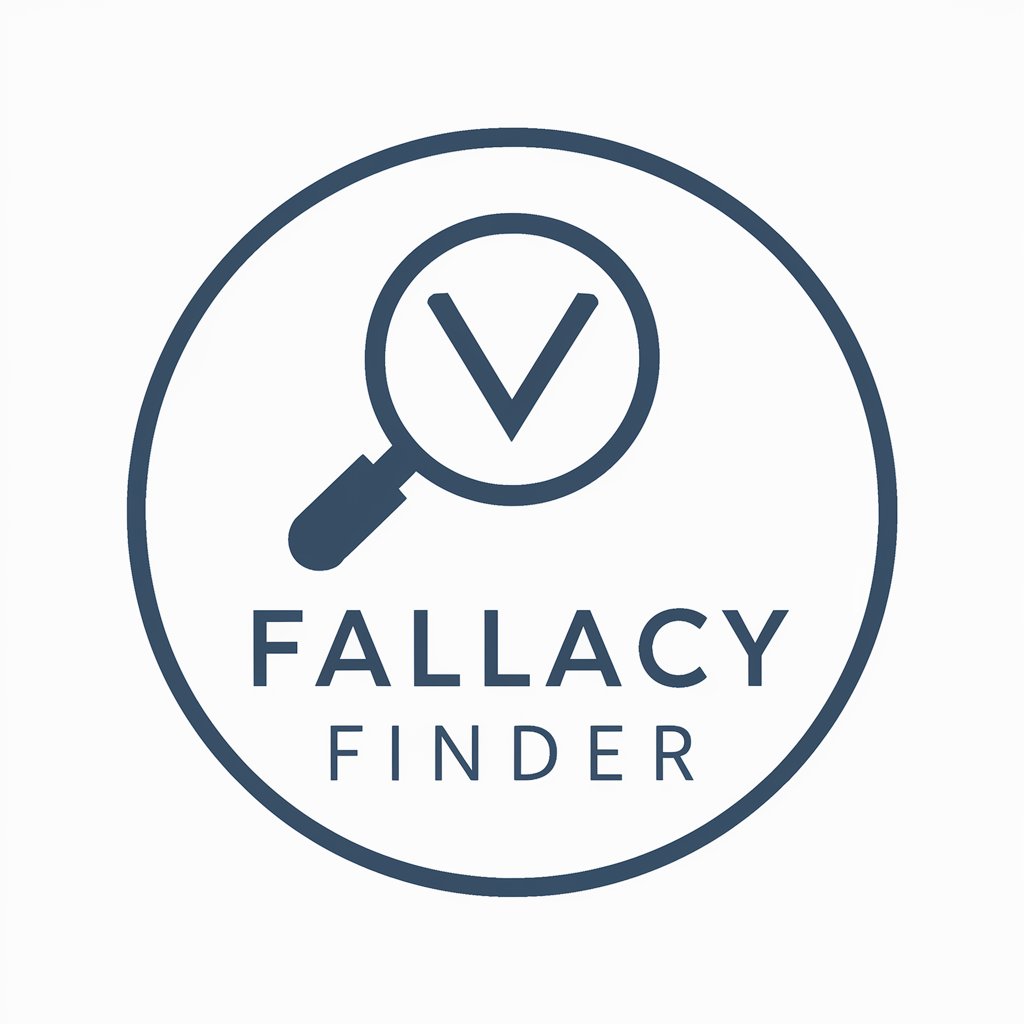Fallacy Finder - Logical Fallacy Identification

Hello! I'm Fallacy Finder, here to help you identify logical fallacies.
Sharpen Your Arguments with AI
Can you identify any logical fallacies in this statement?
What type of fallacy is present in this argument?
Explain why this reasoning might be fallacious.
Is there a logical flaw in this text?
Get Embed Code
Introduction to Fallacy Finder
Fallacy Finder is designed as a specialized tool with the primary aim of identifying and explaining logical fallacies within texts. Logical fallacies are errors in reasoning that undermine the logic of an argument. They can be subtle and often go unnoticed by untrained readers, leading to misunderstandings or acceptance of flawed arguments. The core purpose of Fallacy Finder is to enhance critical thinking and reasoning skills by providing users with the tools to recognize these fallacies in various forms of communication. For example, if a user submits a political speech or an opinion piece, Fallacy Finder would analyze the text to identify any instances of logical fallacies such as ad hominem attacks, where the argument is directed against the person rather than the position they are maintaining, or false dilemmas, where the argument unjustly limits the options to two when more are available. Powered by ChatGPT-4o。

Main Functions of Fallacy Finder
Identification of Logical Fallacies
Example
Ad Hominem, Straw Man, Slippery Slope, etc.
Scenario
When a user presents a debate transcript, Fallacy Finder can pinpoint moments where a speaker may divert from attacking the argument to attacking the person (Ad Hominem), misrepresent an opponent's argument to make it easier to attack (Straw Man), or suggest that a relatively minor first step will inevitably lead to a chain of related (negative) events (Slippery Slope).
Provision of Definitions and Examples
Example
Explanation of 'Begging the Question', with historical examples.
Scenario
If a user encounters a complex argument in an academic paper that seems circular, Fallacy Finder can explain the 'Begging the Question' fallacy, where the argument's premise assumes the truth of the conclusion, instead of supporting it, and provide examples from historical texts or debates to illustrate this fallacy in action.
Educational Guidance
Example
Tips on avoiding logical fallacies in writing or speech.
Scenario
For users crafting arguments for essays, presentations, or debates, Fallacy Finder can offer advice on structuring arguments to avoid common logical fallacies, thereby strengthening their rhetorical effectiveness and credibility.
Ideal Users of Fallacy Finder Services
Students and Educators
Students learning critical thinking, logic, or rhetoric, and educators teaching these subjects will find Fallacy Finder invaluable. It serves as an educational tool to improve understanding of logical fallacies, enhance argumentative writing, and develop critical analysis skills.
Writers and Journalists
Professionals engaged in writing articles, essays, or reports and journalists working on news stories or opinion pieces can use Fallacy Finder to refine their arguments, ensuring they are presenting well-reasoned and logical points to their readers.
Debaters and Public Speakers
Individuals involved in debate clubs, public speaking, or any form of argumentative discourse can benefit from Fallacy Finder by learning to recognize and avoid logical fallacies in their own speeches, thereby improving their persuasiveness and effectiveness.

How to Use Fallacy Finder
Start with a Free Trial
Access Fallacy Finder by visiting yeschat.ai, which offers a free trial without the need for login or a ChatGPT Plus subscription.
Submit Your Text
Enter the text you wish to analyze into the provided text box. This could be an argument, a paragraph, or any piece of writing where logical consistency is key.
Specify Your Needs
If possible, mention any specific areas of concern or types of fallacies you're particularly interested in identifying within your text.
Analyze the Feedback
Review the analysis provided by Fallacy Finder, which includes identification of logical fallacies, explanations for their classification, and suggestions for improvement.
Apply the Insights
Use the insights gained from the analysis to revise your text, enhance the clarity of your arguments, and strengthen your logical reasoning.
Try other advanced and practical GPTs
Resume Builder
Craft Your Success with AI

Smarter Living Coach
Empowering Your Health Journey with AI

What Would Dr. Bob Do?
Navigating sobriety with AI guidance

Bible Buddy
Modern Answers from Ancient Wisdom

Sustainable Business & Finance : Analysis
Empowering Sustainable Decisions with AI

「やさしいにほんご」変換ツール
Simplify Japanese with AI-powered ease.

Salary Increase Letter - Free Custom GPT Prompt
Craft your raise request with AI precision

NPC Architect
Crafting detailed NPCs with AI

Metaverse Academy
Empowering Future-Ready Skills with AI

Homestead Guide
Empowering sustainable living with AI.

Chemistry
Unlocking the World of Chemistry with AI

Bryan StJohn Instant Interview
Unveiling Leadership Qualities with AI

Fallacy Finder Q&A
What is Fallacy Finder?
Fallacy Finder is an AI-powered tool designed to identify and explain logical fallacies in text. It provides users with feedback on potential flaws in reasoning, helping improve argumentative clarity and coherence.
Can Fallacy Finder analyze any type of text?
Yes, Fallacy Finder can analyze a wide range of texts, from academic papers and essays to speeches and debates. However, its effectiveness depends on the clarity of the argumentation presented in the text.
How does Fallacy Finder identify logical fallacies?
Fallacy Finder uses advanced AI algorithms trained on a vast dataset of logical arguments and fallacies. It examines the structure and content of the text to identify inconsistencies, unsupported assumptions, and other common logical errors.
Is Fallacy Finder suitable for educational purposes?
Absolutely. Fallacy Finder serves as an excellent educational tool for students, educators, and anyone looking to improve their critical thinking and argumentation skills. It helps users recognize and understand various logical fallacies in a practical context.
Can Fallacy Finder help with writing and editing?
Yes, Fallacy Finder can be an invaluable aid in the writing and editing process by highlighting areas where the argument may be weak or illogical. This allows writers to refine their work, making their arguments more persuasive and logically sound.
